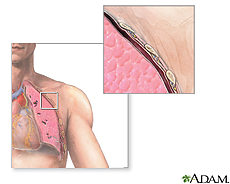The tissue that lines your lungs, stomach, heart and other organs is called mesothelium. Mesothelioma is cancer of that tissue. It is a rare but serious type of cancer. It usually starts in the lungs, but can also start in the abdomen or other organs. Most people who develop mesothelioma have worked on jobs where they inhaled asbestos particles. It can take a long time - 30 to 50 years - between being around asbestos and getting the disease. Treatment includes surgery, radiation, chemotherapy or all three.
National Cancer Institute
- Malignant Mesothelioma (PDQ): Treatment
 (National Cancer Institute)
(National Cancer Institute) Also available in Spanish
- What Is Malignant Mesothelioma?(American Cancer Society)
| Basics | Learn More | Multimedia & Cool Tools |
|---|---|---|
| ||
| Research | Reference Shelf | For You |
|
- Overviews
- Mesothelioma(Mayo Foundation for Medical Education and Research)
- Mesothelioma: Questions and Answers
 (National Cancer Institute)
(National Cancer Institute)
- Diagnosis/Symptoms
- How Is Malignant Mesothelioma Diagnosed?(American Cancer Society)
- How Is Malignant Mesothelioma Staged?(American Cancer Society)
- Treatment
- Chemotherapy for Malignant Mesothelioma(American Cancer Society)
- Pleurodesis(International Mesothelioma Program)
- Radiation Therapy for Malignant Mesothelioma(American Cancer Society)
- Surgery for Malignant Mesothelioma(American Cancer Society)
- Prevention/Screening
- What Are the Risk Factors for Malignant Mesothelioma?(American Cancer Society)
- Disease Management
- Malignant Mesothelioma: What Happens After Treatment?(American Cancer Society)
- Related Issues
- What Should You Ask Your Doctor about Malignant Mesothelioma?(American Cancer Society)
- Clinical Trials
- ClinicalTrials.gov: Mesothelioma
 (National Institutes of Health)
(National Institutes of Health)
- ClinicalTrials.gov: Mesothelioma
- Research
- What's New in Malignant Mesothelioma Research and Treatment?(American Cancer Society)
- Journal Articles
References and abstracts from MEDLINE/PubMed (National Library of Medicine)
- Article: Outcomes after extrapleural pneumonectomy and intensity-modulated radiation therapy for malignant...
- Article: Immunohistochemical detection of XIAP in mesothelium and mesothelial lesions.
- Article: Phase II study of vinflunine in malignant pleural mesothelioma.
- Mesothelioma -- see more articles
- Asbestos related mesothelioma -- see more articles
- Dictionaries/Glossaries
- Glossary of Terms(Mesothelioma Applied Research Foundation)
- Organizations
- American Cancer Society
- American Lung Association
- Mesothelioma Applied Research Foundation
- National Cancer Institute

- Statistics
- What Are the Key Statistics about Malignant Mesothelioma?(American Cancer Society)










